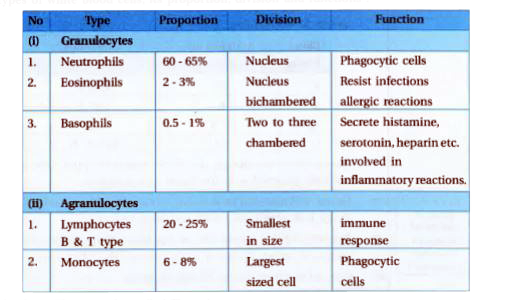Discuss in detail about types, proportion and function of blood corpuscles.
Text Solution
Erythrocystes, Leucocytes and Platelets are collectively called formed elemets.
These elements constitute nearly 45 percents of the blood.
(a) Erythrocytes /Red blood cells (RBC) are the most abundant of all the cells in the blood.
A healthy adult man has an average 5 million to 5.5 million of RBCs mm3 of blood.
RBCs are devoid of nucleus in most of the mammals.
They are biconcave in shape.
They have a red coloured, iron containing complex protein called haemoglobin
A healthy indivdual has 12 - 16 gms of haemoglobin in every 100 ml of blood.
Function : These molecules play a significant role in transport of respiratory gases like O2 and CO2
RBCs are formed in the red bone marrow.
average life span is of 120 days
They are destroyed in spleen.
(b) Leucocytes are colourless due to the lack of haemoglobin.
They are relatively lesser in number which averages 6000-8000 mm3 of blood.
they are short lived.
they are nucleated.
On the basis of presence of granules in cytoplasm there are two types of WBCs : Granulocytes and 2. Agranulocytes.

(c) Platelets : They are also called Thrombocytes.
They are cells fragments produced from megakaryocytes (special cells in the bone marrow).
Blood contains 1,500,00 - 3,500,00 platelets Mm−3.
Platelets ralease a veriety of substances most of which are involved in the coagulation or clotting of blood.
A reduction in their number can lead to clotting disorders which will lead to excessive loss of blood from the body.
|
Topper's Solved these Questions
- BODY FLUIDS AND CIRCULATIONBOOK - KUMAR PRAKASHANCHAPTER - BODY FLUIDS AND CIRCULATIONEXERCISE - SECTION - B (DIFFERENCE / SCIENTIFIC REASONS)
8 Videos
- BODY FLUIDS AND CIRCULATIONBOOK - KUMAR PRAKASHANCHAPTER - BODY FLUIDS AND CIRCULATIONEXERCISE - SECTION - C (DEFINITION / EXPLANATION - TERMS / LOCATION - FUNCTION.)
7 Videos
- BIOMOLECULES BOOK - KUMAR PRAKASHANCHAPTER - BIOMOLECULES EXERCISE - QUESTION PAPER (DESCRIBE IN DETAIL):
1 Videos
- BREATHING AND EXCHANGE OF GASES BOOK - KUMAR PRAKASHANCHAPTER - BREATHING AND EXCHANGE OF GASES EXERCISE - Questions from Module (Question Paper)
11 Videos
Similar Questions
Knowledge Check
Main function of white blood corpuscles is
ATransport of CO2BTransport of oxygenCTo produce immune system of bodyDNone of theseFormation of blood corpuscles is known as
AHaemolysisBRouleauxCHaemopoiesisDPhagocytosisGrave yard of blood corpuscles is
ASpleenBLiverCKidneyDThymus
